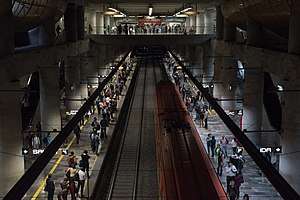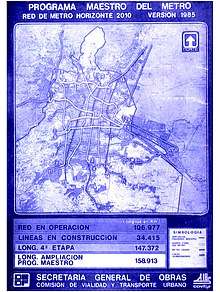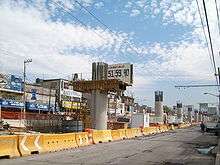Mexico City Metro Line 12
Mexico City Metro Line 12 is one of the twelve metro lines operating in Mexico City, Mexico. Inaugurated in 2012, it is the newest metro line of the system. Its identifying color is gold and it runs through the city from southwest to southeast.
| Line 12 / Línea 12 | ||||||||||||||||||||||||||||||||||||||||||||||||||||||||||||||||||||||||||||||||||||||||||||||||||||||||||||||||||||||||||||||||||||||||||||||||||||||||||||||||||||||||||||||||||||||||||||||
|---|---|---|---|---|---|---|---|---|---|---|---|---|---|---|---|---|---|---|---|---|---|---|---|---|---|---|---|---|---|---|---|---|---|---|---|---|---|---|---|---|---|---|---|---|---|---|---|---|---|---|---|---|---|---|---|---|---|---|---|---|---|---|---|---|---|---|---|---|---|---|---|---|---|---|---|---|---|---|---|---|---|---|---|---|---|---|---|---|---|---|---|---|---|---|---|---|---|---|---|---|---|---|---|---|---|---|---|---|---|---|---|---|---|---|---|---|---|---|---|---|---|---|---|---|---|---|---|---|---|---|---|---|---|---|---|---|---|---|---|---|---|---|---|---|---|---|---|---|---|---|---|---|---|---|---|---|---|---|---|---|---|---|---|---|---|---|---|---|---|---|---|---|---|---|---|---|---|---|---|---|---|---|---|---|---|---|---|---|---|---|
 | ||||||||||||||||||||||||||||||||||||||||||||||||||||||||||||||||||||||||||||||||||||||||||||||||||||||||||||||||||||||||||||||||||||||||||||||||||||||||||||||||||||||||||||||||||||||||||||||
| Overview | ||||||||||||||||||||||||||||||||||||||||||||||||||||||||||||||||||||||||||||||||||||||||||||||||||||||||||||||||||||||||||||||||||||||||||||||||||||||||||||||||||||||||||||||||||||||||||||||
| Type | Rapid transit | |||||||||||||||||||||||||||||||||||||||||||||||||||||||||||||||||||||||||||||||||||||||||||||||||||||||||||||||||||||||||||||||||||||||||||||||||||||||||||||||||||||||||||||||||||||||||||||
| System | Mexico City Metro | |||||||||||||||||||||||||||||||||||||||||||||||||||||||||||||||||||||||||||||||||||||||||||||||||||||||||||||||||||||||||||||||||||||||||||||||||||||||||||||||||||||||||||||||||||||||||||||
| Locale | Mexico City | |||||||||||||||||||||||||||||||||||||||||||||||||||||||||||||||||||||||||||||||||||||||||||||||||||||||||||||||||||||||||||||||||||||||||||||||||||||||||||||||||||||||||||||||||||||||||||||
| Termini | Mixcoac Tláhuac | |||||||||||||||||||||||||||||||||||||||||||||||||||||||||||||||||||||||||||||||||||||||||||||||||||||||||||||||||||||||||||||||||||||||||||||||||||||||||||||||||||||||||||||||||||||||||||||
| Stations | 20 | |||||||||||||||||||||||||||||||||||||||||||||||||||||||||||||||||||||||||||||||||||||||||||||||||||||||||||||||||||||||||||||||||||||||||||||||||||||||||||||||||||||||||||||||||||||||||||||
| Ridership | 369,590 passengers per day (2019)[1] | |||||||||||||||||||||||||||||||||||||||||||||||||||||||||||||||||||||||||||||||||||||||||||||||||||||||||||||||||||||||||||||||||||||||||||||||||||||||||||||||||||||||||||||||||||||||||||||
| Operation | ||||||||||||||||||||||||||||||||||||||||||||||||||||||||||||||||||||||||||||||||||||||||||||||||||||||||||||||||||||||||||||||||||||||||||||||||||||||||||||||||||||||||||||||||||||||||||||||
| Opened | 30 October 2012 | |||||||||||||||||||||||||||||||||||||||||||||||||||||||||||||||||||||||||||||||||||||||||||||||||||||||||||||||||||||||||||||||||||||||||||||||||||||||||||||||||||||||||||||||||||||||||||||
| Operator(s) | Sistema de Transporte Colectivo (STC) | |||||||||||||||||||||||||||||||||||||||||||||||||||||||||||||||||||||||||||||||||||||||||||||||||||||||||||||||||||||||||||||||||||||||||||||||||||||||||||||||||||||||||||||||||||||||||||||
| Rolling stock | FE-10 | |||||||||||||||||||||||||||||||||||||||||||||||||||||||||||||||||||||||||||||||||||||||||||||||||||||||||||||||||||||||||||||||||||||||||||||||||||||||||||||||||||||||||||||||||||||||||||||
| Technical | ||||||||||||||||||||||||||||||||||||||||||||||||||||||||||||||||||||||||||||||||||||||||||||||||||||||||||||||||||||||||||||||||||||||||||||||||||||||||||||||||||||||||||||||||||||||||||||||
| Line length | 24.110 km (15 mi) | |||||||||||||||||||||||||||||||||||||||||||||||||||||||||||||||||||||||||||||||||||||||||||||||||||||||||||||||||||||||||||||||||||||||||||||||||||||||||||||||||||||||||||||||||||||||||||||
| Track length | 25.100 km (16 mi) | |||||||||||||||||||||||||||||||||||||||||||||||||||||||||||||||||||||||||||||||||||||||||||||||||||||||||||||||||||||||||||||||||||||||||||||||||||||||||||||||||||||||||||||||||||||||||||||
| Track gauge | 1,435 mm (4 ft 8 1⁄2 in) standard gauge | |||||||||||||||||||||||||||||||||||||||||||||||||||||||||||||||||||||||||||||||||||||||||||||||||||||||||||||||||||||||||||||||||||||||||||||||||||||||||||||||||||||||||||||||||||||||||||||
| Electrification | Catenary | |||||||||||||||||||||||||||||||||||||||||||||||||||||||||||||||||||||||||||||||||||||||||||||||||||||||||||||||||||||||||||||||||||||||||||||||||||||||||||||||||||||||||||||||||||||||||||||
| ||||||||||||||||||||||||||||||||||||||||||||||||||||||||||||||||||||||||||||||||||||||||||||||||||||||||||||||||||||||||||||||||||||||||||||||||||||||||||||||||||||||||||||||||||||||||||||||
At the moment of its inauguration, the line was also called Línea Dorada (Golden Line) and Línea del Bicentenario (Bicentennial Line), the latter to commemorate the Bicentenary of the Mexican War of Independence and the Centenary of the Mexican Revolution in 2010, despite the fact that the line was officially inaugurated two years later.
General information
Line 12 has 20 stations, out of which four are transfer stations: Mixcoac with Line 7, Zapata with Line 3, Ermita with Line 2, and Atlalico with Line 8. When the planned extension of the line is completed, Line 12 will also connect with Line 1 at Observatorio.[2] An extension of Line 9 is also under construction, thus, Line 12 will also connect with Line 9 at Observatorio.[3]
The line runs under Eje 7 Sur from the Mixcoac terminal to Parque de los Venados, from Parque de los Venados to Eje Central ir runs under Av. División del Norte, from Eje Central to Atlalilco it runs under Eje 8 Sur. From Atlalilco to Zapotitlán it runs on an elevated viaduct over Av. Tláhuac. From Tlaltenco to Tláhuac it runs at surface level.
Alongside Line B, Line 12 is one of the two metro lines of the network to feature the three type of stations in the network: underground, elevated and surface.
Access to Line 12 is possible only with a public transportation card, which can be bought at any of the network stations, this card is also valid for Metrobús and any other system in the whole Mexico City transport network.[4] This is the only line that no longer allows access through tickets.
Also, Line 12 is the only line to forbid the access to the stations to hawkers. It is common to see these individuals selling merchandise in all the other 11 lines of the system.[5]
History
Chronology
| Date | Stretch | Stations | Length | Total length |
|---|---|---|---|---|
| 30 October 2012 | Mixcoac–Tláhuac | 20 | 12.66 km | 12.66 km |
Origins

In the eighties, the Comisión de Vialidad y Transporte Urbano (COVITUR), an organization of the Departamento del Distrito Federal, presented a plan for the Mexico City Metro based on several studies and reports related to the rapid growth of the city and its demand for public transportation. On the so called Programa Maestro del Metro (Metro Master Plan), COVITUR considered a metro line that would run on the southern part of Mexico City from west to east, the line was designated as Line 12.[6]
This line would run from Álvaro Obregón to the west to Constitución de 1917 in Iztapalapa to the east. It would have seventeen stations and a length of 18.97 km and it would connect with Lines 2, 4, 3, 7 and 13, another planned line.[6]
By the 1990s no Line 12 was built. But in 1996, the Sistema de Transporte Colectivo published its plan for the next 25 years, the Plan Maestro del Metro y Trenes Ligero (Metro and Light Rail Master Plan). This document considered the new demand for public transport as well as the urban expansion towards the suburbs and the State of Mexico. Line 12 again appeared in the plan, with some changes, but the route was almost the same.[7]
The 1996 Line 12 project would start in Santa Lucía in Álvaro Obregón and end at a station called Francisco del Paso in Iztacalco. The idea was that both Line 8 and Line 12 would share Francisco del Paso as a transfer station; then, the stretch of Line 8 going from this new station to Constitución de 1917 would be transferred to Line 12, while Line 8 would have a new expansion from Francisco del Paso to the south in Tlalpan. Therefore, Line 12 would have almost the same route that in the 1985 plan, from Álvaro Obregón to Constitución de 1917.[7] None of these projects materialized and Line 12 was not mentioned again until the new century.
In December 2006, the possible construction of a new metro line to satisfy the demand for public transportation in the south of Mexico City was announced, taking in consideration Line 12's original plans. Mexico City's government announced a query among its citizens to choose between two routes. The line would go from Mixcoac to Iztapalapa; from there, there were two choices: Iztapalapa–Acoxpa or Iztapalapa–Tláhuac.[8]
The winning route was Iztapalapa–Tláhuac. Back then, Tláhuac, one of the easternmost Mexico City boroughs, did not have metro service. The new route followed almost the same plan for 1985's Line 11 from Culhuacán to Periférico Oriente (almost all station's name changed); except from the fact that this line was projected to end in Iztapalapa and not in Tláhuac.[6]
On 8 August 2007 the project was officially presented as Línea 12: línea dorada, la línea del Bicentenario (Line 12: Golden Line, the Bicentennial Line) and, thus, its chosen distinctive color was golden.[9]
Construction

Construction of the first leg of the line, Tláhuac–Atlalilco, started on 23 September 2008.[10] The second stretch of the line, from Atlalilco to Mixcoac was finished on April 2012.
The line was inaugurated on 30 October 2012 by Marcelo Ebrard, Head of Government of the Federal District from 2006 to 2012 and Felipe Calderón, President of Mexico from 2006 to 2012.[11]
Temporary partial closure
In an unprecedented event in the history of Mexico City Metro, Line 12 had to be shut down temporarily in the stretch Tláhuac–Atlalilco due to severe faults in its infrastructure. This section is the one that corresponds to the elevated stretch of the line.[12]
The technical and structural faults of the elevated stretch caused the trains to run on the verge of derailment, due to wear on the rails that provoked slopes and damage to the tires of the trains, putting six out of the 30 trains out of service.[12]
The stretch was closed between 12 March 2014 and 29 November 2015, when the section going from Tezonco to Tláhuac was officially reopened by Miguel Ángel Mancera, Head of Government of the Federal District from 2012 to 2018.[13][14] Previously, on October 27, 2015, the stretch Periférico Oriente–Culhuacán, resumed the service, but all trains stopped at Periférico Oriente station till the service on the whole line was reestablished.[15]
2017 earthquake
On 19 September 2017 a 7.1 magnitude earthquake hit Mexico City and other zones of Central Mexico, affecting Line 12 with electrical power shortages and the derailing of a train between the Nopalera and Zapotitlán stations.[16] Due to this, and potential damages to the line's infrastructure, service in the Tláhuac–Culhuacán section of the line was suspended.[17]
After evaluations, it was determined that the line had visible damages in the tracks and structural faults.[18] Therefore, the stretch from Olivos to Tláhuac was closed for repairs. Service in all the closed stations was resumed on 30 October 2017.[19]
Expansion
.jpg)
In 2017 an expansion for Line 12 was announced. Construction started on 29 November 2017[20][21]. The extension was expected to be completed by 2020, but works were delayed, thus, being projected to open by 2021.[22]
This project will extend the line from Mixcoac to Observatorio, where it will connect with Line 1 and it will have three new stations and a length of 3.5 km. The two new stations are: Valentín Campa and Álvaro Obregón, both situated in the Álvaro Obregón municipality. The totality of the extension is being constructed underground.
The original 1985 and 1996 plans for Line 12 considered the line going westward from Mixcoac with two new stations, as in the undergoing expansion. Nevertheless, the connection with Line 1 at Observatorio was not planned in none of the projects.[6][7]
Rolling stock
Line 12 has a total of 30 FE-10 trains, with seven cars each. The FE-10 has a total capacity of 1475 passengers, 336 seated and 1139 standing.[23] The trains were built by Construcciones y Auxiliar de Ferrocarriles in Spain.
Line 12 is the only line so far to feature FE-10 trains.
Station list
| No. | Station | Date opened | Level | Distance (km) | Transfers | Location | |
|---|---|---|---|---|---|---|---|
| Between stations |
Total | ||||||
| 01 | Mixcoac | October 30, 2012 | Underground, deep trench |
- | 0.0 |
|
Benito Juárez |
| 02 | Insurgentes Sur | October 30, 2012 | Underground, deep trench |
0.8 | 0.8 |
| |
| 03 | Hospital 20 de Noviembre | October 30, 2012 | Underground, deep trench |
0.9 | 1.7 |
| |
| 04 | Zapata | October 30, 2012 | Underground, deep trench |
0.6 | 2.3 |
| |
| 05 | Parque de los Venados | October 30, 2012 | Underground, deep trench |
0.7 | 3.0 |
| |
| 06 | Eje Central | October 30, 2012 | Underground, deep trench |
1.4 | 4.4 |
| |
| 07 | Ermita | October 30, 2012 | Underground, deep trench |
1.0 | 5.4 |
| |
| 08 | Mexicaltzingo | October 30, 2012 | Underground, trench |
2.0 | 7.4 | Iztapalapa | |
| 09 | Atlalilco | October 30, 2012 | Underground, trench |
2.1 | 9.5 |
| |
| 10 | Culhuacán | October 30, 2012 | Elevated | 1.8 | 11.3 |
| |
| 11 | San Andrés Tomatlán | October 30, 2012 | Elevated | 1.1 | 12.4 |
| |
| 12 | Lomas Estrella | October 30, 2012 | Elevated | 1.2 | 13.6 |
| |
| 13 | Calle 11 | October 30, 2012 | Elevated | 1.1 | 14.7 | ||
| 14 | Periférico Oriente | October 30, 2012 | Elevated | 1.3 | 16.0 |
|
Tláhuac |
| 15 | Tezonco | October 30, 2012 | Elevated | 1.7 | 17.7 | ||
| 16 | Olivos | October 30, 2012 | Elevated | 0.6 | 18.3 | ||
| 17 | Nopalera | October 30, 2012 | Elevated | 1.5 | 19.8 | ||
| 18 | Zapotitlán | October 30, 2012 | Elevated | 1.5 | 21.3 | ||
| 19 | Tlaltenco | October 30, 2012 | Surface | 1.3 | 22.6 | ||
| 20 | Tláhuac | October 30, 2012 | Surface | 1.5 | 24.1 | CETRAM (Bus platforms) for Tulyehualco, Milpa Alta, and Chalco | |
Extension
A possible extension of the line, to connect it with Line 1 at the Observatorio station was announced on February 2013, thus making Observatorio the new west terminus of the line, instead of Mixcoac.[2] The project was approved on September 2013 by Gerardo Ruiz Esparza, Secretary of Communications and Transportation.[24]
Construction started on 29 November 2017[25][26]. The extension was expected to be completed by 2020, but works were delayed, thus, being projected to open by 2021.[27]
The stretch will have two new stations, Álvaro Obregón and Valentín Campa, both in the Álvaro Obregón municipality, and it will finally connect with the Observatorio terminal.
| No. | Station | Date opened | Situation | Distance (km) | Transfers | Location | |
|---|---|---|---|---|---|---|---|
| Between stations |
Total | ||||||
| 21 | Valentín Campa | Expected 2020 | Underground, deep tunnel |
1.5 | 25.6 | Álvaro Obregón | |
| 22 | Álvaro Obregón | Expected 2021 | Underground, deep tunnel |
1.4 | 27.0 | ||
| 23 | Observatorio | Expected 2021 | Underground, deep tunnel |
0.6 | 27.6 |
--- under construction --- --- planned --- | |
Ridership
The following table shows each of Line 12 stations total and average daily ridership during 2019.[1]
| † | Transfer station |
| ‡ | Terminal |
| †‡ | Transfer station and terminal |
| Rank | Station | Total ridership | Average daily |
|---|---|---|---|
| 1 | Tláhuac‡ | 20,743,670 | 56,832 |
| 2 | Insurgentes Sur | 12,976,044 | 35,551 |
| 3 | Periférico Oriente | 12,095,813 | 33,139 |
| 4 | Tezonco | 8,443,023 | 23,132 |
| 5 | Nopalera | 8,209,571 | 22,492 |
| 6 | Mexicaltzingo | 6,981,386 | 19,127 |
| 7 | Olivos | 6,513,892 | 17,846 |
| 8 | Mixcoac†‡ | 5,956,326 | 16,319 |
| 9 | Culhuacán | 5,583,585 | 15,297 |
| 10 | Calle 11 | 5,309,588 | 14,547 |
| 11 | Zapata† | 5,187,865 | 14,213 |
| 12 | Atlalilco† | 5,112,833 | 14,008 |
| 13 | Zapotitlán | 4,994,118 | 13,683 |
| 14 | San Andrés Tomatlán | 4,514,716 | 12,369 |
| 15 | Lomas Estrella | 4,481,178 | 12,277 |
| 16 | Hospital 20 de Noviembre | 4,290,490 | 11,755 |
| 17 | Parque de los Venados | 4,249,439 | 11,642 |
| 18 | Eje Central | 4,077,416 | 11,171 |
| 19 | Ermita† | 3,904,630 | 10,698 |
| 20 | Tlaltenco | 1,274,784 | 3,493 |
| Total | 134,900,367 | 369,590 | |
See also
References
- "Afluencia de estación por línea 2019" (in Spanish). Metro CDMX. Retrieved 25 April 2020.
- "Ampliarán Línea 12 del Metro del DF". Sipse (in Spanish). February 14, 2013. Retrieved July 27, 2018.
- "Metro alista ampliación de Línea 9 a Observatorio". El Universal (in Spanish). July 15, 2017. Retrieved November 20, 2018.
- "Entra en operación la tarjeta universal del DF en el Metro y Metrobús". Animal Político (in Spanish). October 17, 2012. Retrieved August 21, 2018.
- "Se impedirá comercio informal a lo largo de la línea 12 del Metro, afirma delegado". La Jornada (in Spanish). October 16, 2012. Retrieved August 21, 2018.
- Programa Maestro del Metro (2a Rev.). Comisión de Vialidad y Transporte Urbano. 1985. p. 69.
- Plan Maestro del Metro y Trenes Ligeros. Sistema de Transporte Colectivo. 1996. p. 90.
- Cuenca, Alberto (25 July 2007). "Ebrard invita a 'votar' por ruta del Metro a Tláhuac". El Universal (in Spanish). Retrieved 4 May 2020.
- "La Línea 12 del Metro a través del tiempo". La Silla Rota (in Spanish). 27 December 2018. Retrieved 4 May 2020.
- "Línea 12 arranca construcción a vapor". Excélsior (in Spanish). 21 September 2008. Archived from the original on 9 December 2008.
- "FCH: Línea 12, esfuerzo de voluntades; reconoce a Ebrard". El Universal (in Spanish). 30 October 2012. Retrieved 27 July 2018.
- "¿Por qué el GDF cerró la Línea 12 del Metro?". Aristegui Noticias (in Spanish). 11 March 2014. Retrieved 8 August 2018.
- "Metro gastó 420 mdp en RTP durante cierre de Línea 12". Excélsior (in Spanish). 2 December 2015. Retrieved 8 August 2018.
- "Reabre en su totalidad la L12; no volverá a cerrar: Mancera". El Universal (in Spanish). 29 November 2015. Retrieved 8 August 2018.
- "Gobierno capitalino reporta descarrilamiento de tren en Línea 12. Con Paola Rojas". Excélsior (in Spanish). 19 September 2017. Retrieved 8 August 2018.
- "'No se permitirá que el Metro caiga en un bache'; reabren 5 estaciones de L12". Radio Fórmula (in Spanish). September 19, 2017. Retrieved 8 August 2018.
- "Reencausamos tren en Línea 12 que por sismo se salió de vías: Gaviño. Con José Cárdenas". Radio Fórmula (in Spanish). 19 September 2017. Retrieved 8 August 2018.
- "Vecinos temen colampso de Línea 12 del Metro por sismo". El Universal (in Spanish). 21 September 2017. Retrieved 8 August 2018.
- "Este lunes, en funcionamiento todas las estaciones de la L12". El Universal (in Spanish). 29 October 2017. Archived from the original on 3 November 2017. Retrieved 8 August 2018.
- "Arranca construcción para ampliar Línea 12 del Metro". Quadratín (in Spanish). 29 November 2017. Retrieved 27 July 2018.
- "Ampliación de L12 del Metro podría concluir en 2019: Mancera". El Universal (in Spanish). 17 November 2017. Retrieved 27 July 2018.
- "Hasta 2021 terminará ampliación de Línea 12 del Metro: Sheinbaum". El Heraldo de México (in Spanish). 27 December 2018. Retrieved 16 March 2020.
- "Parque vehicular". Metro CDMX. Retrieved 27 April 2020.
- "Dan el sí a la ampliación de la Línea 12 del Metro". El Universal (in Spanish). 7 September 2013. Archived from the original on 14 April 2016. Retrieved 27 July 2018.
- "Arranca construcción para ampliar Línea 12 del Metro". Quadratín (in Spanish). 29 November 2017. Retrieved 27 July 2018.
- "Ampliación de L12 del Metro podría concluir en 2019: Mancera". El Universal (in Spanish). 17 November 2017. Retrieved 27 July 2018.
- "Hasta 2021 terminará ampliación de Línea 12 del Metro: Sheinbaum". El Heraldo de México (in Spanish). 27 December 2018. Retrieved 16 March 2020.